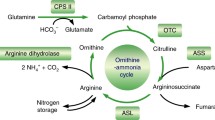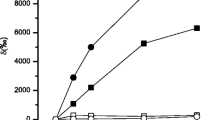Abstract
The pathways of assimilation of ammonium by pure cultures of symbiont-free Anthoceros punctatus L. and the reconstituted Anthoceros-Nostoc symbiotic association were determined from time-course (5–300 s) and inhibitor experiments using 13NH +4 . The major product of assimilation after all incubation times was glutamine, whether the tissues were cultured with excess ammonium or no combined nitrogen. The 13N in glutamine was predominantly in the amide-nitrogen position. Formation of glutamine and glutamate by Anthoceros-Nostoc was strongly inhibited by either 1mM methionine sulfoximine (MSX) or 1 mM exogenous ammonium. These data are consistent with the assimilation of 13NH +4 and formation of glutamate by the glutamine synthetase (EC 6.3.1.2)-glutamate synthase (EC 1.4.7.1) pathway in dinitrogen-grown Anthoceros-Nostoc. However, in symbiont-free Anthoceros, grown with 2.5 mM ammonium, formation of glutamine, but not glutamate, was decreased by either MSX or exogenous ammonium. These results indicate that during short incubation times ammonium is assimilated in nitrogenreplete Anthoceros by the activities of both glutamine synthetase and glutamate dehydrogenase (EC 1.4.1.2). In-vitro activities of glutamine synthetase were similar in nitrogen-replete Anthoceros and Anthoceros-Nostoc, indicating that the differences in the routes of glutamate formation were not based upon regulation of synthesis of the initial enzyme of the glutamine synthetase-glutamate synthase pathway. When symbiont-free Anthoceros was cultured for 2 d in the absence of combined nitrogen, total 13NH +4 assimilation, and glutamine and glutamate formation in the presence of inhibitors, were similar to dinitrogen-grown Anthoceros-Nostoc. The routes of immediate (within 2 min) glutamate formation and ammonium assimilation in Anthoceros were apparently determined by the intracellular levels of ammonium; at low levels the glutamine synthetase-glutamate synthase pathway was predominant, while at high levels independent activities of both glutamine synthetase and glutamate dehydrogenase were expressed.
Similar content being viewed by others
Abbreviations
- MSX:
-
L-Methionine-DL-sulfoximine
- Mes:
-
2(N-morpholino)ethanesulfonic acid
References
Brenchley, J.E. (1973) Effect of methionine sulfoximine and methionine sulfoxone on glutamate synthesis in Klebsiella aerogenes. J. Bacteriol. 114, 666–673
Chambers, S., Morris, M., Smith, D.C. (1976) Lichen physiology. XV. The effect of digitonin and other treatments on biotrophic transport of glucose from alga to fungus in Peltigera polydactyla. New Phytol. 76, 485–500
Chasko, J.H., Thayer, J.R. (1981) Rapid concentration and purification of 13N-labelled anions on a high performance anion exchanger. Int. J. Appl. Radiat. Isot. 32, 645–649
Enderlin C.S., Meeks, J.C. (1983) Pure culture and reconstitution of the Anthoceros-Nostoc symbiotic association. Planta 158, 157–165
Ito, O., Yoneyama, T., Kumazawa, K. (1978) Amino acid metabolism in plant leaf. IV. The effect of light on ammonium assimilation and glutamine metabolism in the cells isolated from spinach leaves. Plant Cell Physiol. 19, 1109–1119
Lowry, O.H., Rosebrough, N.J., Farr, N.L., Randall, R.J. (1951) Protein measurements with the Folin phenol reagent. J. Biol. Chem. 93, 265–275
Meeks, J.C. (1981) Radiotracer studies of nitrogen metabolism in cyanobacteria. In: Recent advances in chemistry, ser. no. 197: Short-lived radionuclides in chemistry and biology, pp. 269–294, Root, J.W., Krohn, K.A., eds., American Chemical Society, Washington, D.C.
Meeks, J.C., Wolk, C.P., Schilling, N., Shaffer, P.W., Avissar, Y., Chien, W.-S. (1978) Initial organic products of fixation of [13N]dinitrogen by root nodules of soybean (Glycine max). Plant Physiol. 61, 980–983
Miflin, B.J., Lea, P.J. (1980) Ammonia assimilation. In: The biochemistry of plants, vol. 5: Amino acids and derivatives, pp. 169–202, Miflin, B.J., ed. Academic Press, New York London
Parks, N.J., Krohn, K.A. (1978) The synthesis of 13N-labelled ammonia, dinitrogen, nitrite, and nitrate using a single cyclotron target system. Int. J. Appl. Radiat. Isot. 29, 754–756
Rai, A.N., Rowell, P., Stewart, W.D.P. (1981) 15N2 incorporation and metabolism in the lichen Peltigera aphthosa Willd. Planta 152, 544–552
Ray, T.B., Peters, G.A., Toia, R.E., Jr., Mayne, B.C. (1978) Azolla-Anabaena relationship. VII. Distribution of ammonia-assimilating enzymes, protein, and chlorophyll between host and symbiont. Plant Physiol 62, 463–467
Rhodes, D., Rendon, G.A., Stewart, G.R. (1976) The regulation of ammonia assimilating enzymes in Lemna minor. Planta 129, 203–210
Rhodes, D., Sims, A.P., Folkes, B.F. (1980) Pathway of ammonia assimilation in illuminated Lemna minor. Phytochemistry 19, 357–365
Schubert, K.R., Coker, G.T., III (1980) Nitrogen and carbon assimilation in N2-fixing plants: short term studies using 13N and 14C. In: Recent advances in chemistry, ser. no. 197: Short-lived radionuclides in chemistry and biology, pp. 317–339, Root, J.W., Krohn, K.A., eds. American Chemical Society, Washington, D.C.
Skokut, T.A., Wolk, C.P., Thomas, J., Meeks, J.C., Shaffer, P.W., Chien, W.-S. (1978) Initial organic products of assimilation of [13N]ammonium and [13N]nitrate by tobacco cells cultured on different sources of nitrogen. Plant Physiol. 62, 299–304
Solórzano, L. (1969) Determination of ammonia in natural waters by the phenolhypochlorite method. Limnol. Oceanogr. 14, 799–801
Stadtman, E.R., Ginsburg, A., Ciardi, J.E., Yeh, J., Henning, A.B., Shapiro, B.M. (1970) Multiple molecular forms of glutamine synthetase produced by enzyme catalyzed adenylylation and deadenylylation reactions. Adv. Enzyme Regul. 8, 99–118
Stewart, G.R., Mann, A.F., Fentem, P.A. (1980) Enzymes of glutamate formation: glutamate dehydrogenase, glutamine synthetase, and glutamate synthase. In: The biochemistry of plants, vol. 5: Amino acids and derivatives, pp. 271–327, Miflin, B.J., ed. Academic Press, New York London
Vaalburg, W., Kamphuis, J.A.A., Beerling van de Molen, H.D., Reiffers, S., Rijskamp, A., Worldring, M.G., (1975) An improved method for the cyclotron production of 13N-labelled ammonia. Int. J. Appl. Radiat. Isot. 26, 316–318
Wohlhueter, R.M., Schutt, H., Holzer, H. (1973) Regulation of glutamine synthesis in vivo in E. coli. In: The enzymes of glutamine metabolism, pp. 45–64, Prusiner, S., Stadtman, E.R., eds. Academic Press, New york London
Wolk, C.P., Thomas, J., Shaffer, P.W., Austin, S.M., Galonsky, A. (1976) Pathway of nitrogen metabolism after fixation of 13N-labeled nitrogen gas by the cyanobacterium Anabaena cylindrica. J. Biol. Chem. 251, 5027–5034
Author information
Authors and Affiliations
Rights and permissions
About this article
Cite this article
Meeks, J.C., Enderlin, C.S., Wycoff, K.L. et al. Assimilation of 13NH +4 by Anthoceros grown with and without symbiotic Nostoc . Planta 158, 384–391 (1983). https://doi.org/10.1007/BF00397729
Received:
Accepted:
Issue Date:
DOI: https://doi.org/10.1007/BF00397729




